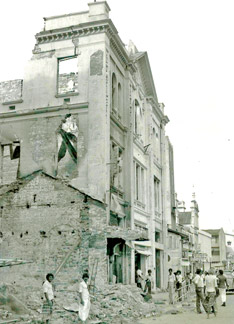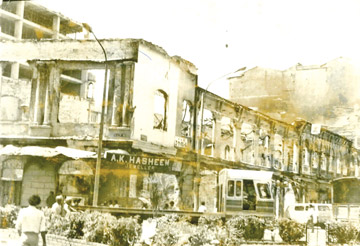|
Black July 1983 anniversary :
‘Move beyond memories towards
reconciliation’– Minister Swaminathan
The country should engage in more efforts for inter-ethnic reconciliation and
peace-building to bridge the gulf between communities, say both civil society
activists as well as government leaders, as Sri Lanka remembers the largest ever
inter-ethnic rioting in modern Sri Lanka that occurred 33 years ago in July
1983.
 |
 |
|
Thirty three years
following the fateful events now known as ‘Black July’ which
engulfed many parts of Sri Lanka in flames and turmoil, the
country is slowly coming to terms with the tragedy as post-war
peace building efforts, including constitutional reform, gather
momentum under the government’s leadership.
|
The week-long rioting that began on July 23rd 1983 was marked as one of the
darkest periods in the history of the country, as ethnic violence spread through
the island, with many men, women and children losing their lives, or their kith
and kin or their homes, businesses and possessions.
Thirty three years following the fateful events now known as ‘Black July’ which
engulfed many parts of Sri Lanka in flames and turmoil, the country is slowly
coming to terms with the tragedy as post-war peace building efforts, including
constitutional reform, gather momentum under the government’s leadership.
“Looking back, the political leaderships now feel that the country is on its way
to reconciliation,” D.M. Swaminathan, Minister of Rehabilitation, Resettlement
and Hindu Religious Affairs told the Sunday Observer. “The date is a terrible
date on the calendar for many concerned but we have to move on beyond these
memories and concentrate on reconciliation,” he said.
“With the constitutional reforms that the country is engaged in it is evident we
are making good progress,” he noted. However, Swaminathan cautioned against
extremist elements working to spark conflict yet again. This was evident in the
recent clash between two student groups from Jaffna University, he said.
Executive Director of the National Peace Council, Jehan Perera, however, feels
that much more needs to be done in terms of reconciliation.
“Thirty three years after Black July, Sri Lanka still needs greater and
ceaseless efforts to promote inter-ethnic harmony. There needs to be
people-to-people dialogue and exchange among all sections in society in general,
to continue this peace building effort,” he said.
In the light of the recent student clash in the Jaffna University, the Peace
Council has proposed that the ethnic mix of university campus student
populations should be proportionate to the ethnic composition of local
communities in which they are situated. Elaborating, Dr. Perera said, “…in the
Science Faculty of the Jaffna University, 60% of the students are Sinhalese, and
in the Science Faculty of the Eastern University, the Sinhala students amount to
80%. If there had been such a high percentage of Tamil or Muslim students in
Ruhuna University, that would have caused friction too.”
The difference is that, Perera explained, when last week’s incident occurred,
the government showed great interest in putting an end to the conflict and
investigating the situation impartially. Numerous statements were issued by
academics from the University of Jaffna and civil society organizations,
expressing their concern and advocating tolerance and understanding.
Chandrasena Maliyedda, the Director General of the Office for National Unity and
Reconciliation (ONUR), stressed that the clash in Jaffna should not be
considered as religious or racial. “Today, Sri Lanka is trying to come to terms
with the peace process, this was an unfortunate incident that needs to be
addressed separately,” he said.
The incident in Jaffna would not jeopardize the reconciliation process, he said.
He commented that the government had responded to the Jaffna incident in an
acceptable and democratic way, which was not the case in 1983. |

